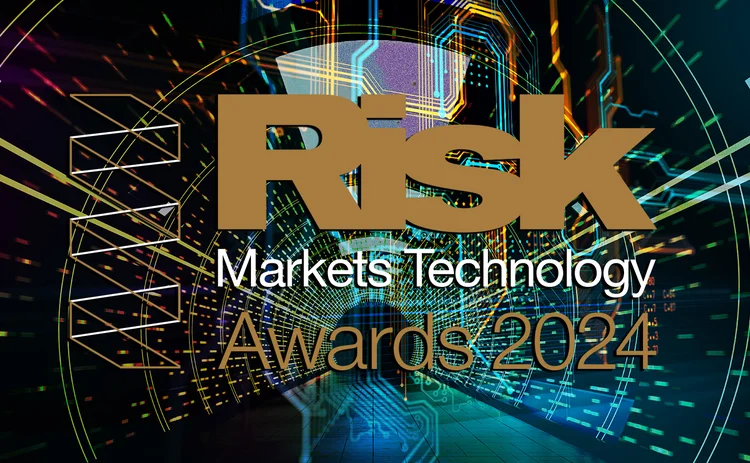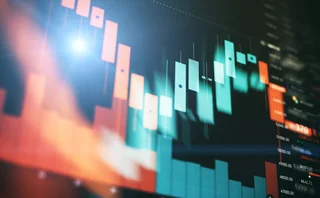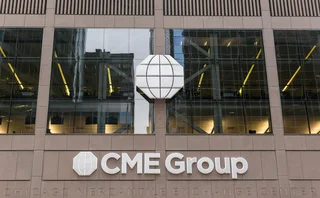
Markets Technology Awards 2024: Fixes for the ‘forgotten middle’
Vendors spy opportunity in demystifying and democratising – opening up markets and methods to new users

In 2021, Chris Churchman landed a new job at Goldman Sachs and was casting around for ways to lure clients to the bank’s Marquee platform, its digital platform for institutional clients.
Churchman had previously worked as an exotic foreign exchange derivatives trader, and started thinking about how he made his trading decisions. He realised that on pretty much every trade he had ever done he would first start with a chart, then toggle to Excel – in some cases spending hours analysing the various risk factors. When it came to explaining the trade, he would always go back to a chart to illustrate why it made sense and how it would make money.
“I realised something quite profound. Why not just do it all on a chart – and use that chart as the interface itself? All the variations, all the scenarios, all the back testing,” he says.
After nine months of development, the Marquee team came up with its Visual Structuring tool, initially launched just over a year ago. With a few clicks, Churchman shows how the chart interface can explore the risks and potential profits of a complex trade – in this case, a one-year call option with a six-month window and two knockouts – making it easier for a client to understand.
Why not just do it all on a chart – and use that chart as the interface itself? All the variations, all the scenarios, all the back testing
Chris Churchman, Goldman Sachs
The chart itself can be used to create and amend a wide range of scenarios, with users having the power to edit parameters including market data, implied probabilities, target levels of risk and reward, and upcoming market-moving events. Trades can be back-tested and shared with colleagues.
Churchman argues the tool makes trading derivatives easier, comparing it to the way Amazon’s pre-sale analytics help a customer go from knowing they want to buy Lego to selecting a specific set. In the process, he believes the bank is helping to demystify the market – and, of course, he hopes it will result in Goldman booking more business with a wider range of institutional clients.
“Historically, a lot of these concepts have been really intimidating,” says Churchman. “In order for that market to grow, you need to democratise understanding of these more complex products.”
The 140 submissions to this year’s Markets Technology Awards revealed a number of firms with a similar conviction – each of them trying to increase transparency or knock down operational barriers that still exist for many clients.
“Forgotten middle”
Eric Huttman, founder of MillTechFX, recognises the trend.
“Why is there a wave of democratisation now? Because it’s about time,” he says.
When Huttman joined hedge fund Millennium Global as portfolio manager in 2016, he saw the firm was trading a colossal $750 billion of FX per year as part of its investment management activities.
The firm had spent a lot of time and money building up its currency execution capabilities, and was one of the market’s top-tier buy-side participants, but it did not generate any revenue from the sunk costs of this internal function. Separately, Huttman had also noticed there was a large group of middle-market clients who found it difficult to trade in the wholesale FX markets.
He had what he calls a “lightbulb moment”. What if Millennium could sell its execution capabilities – its relationships with counterparty banks – to smaller players that could not access wholesale FX markets? Huttman and the team spent a couple of years developing a platform to do just that, spinning out MillTechFX as a sister company to the hedge fund in 2019.
Why is there a wave of democratisation now? Because it’s about time
Eric Huttman, MillTechFX
“Our objective was to democratise access to the wholesale foreign exchange market for those in the middle who are not trading because they want to – they’re trading because they have to,” says Huttman.
He calls the companies his firm targets the “forgotten middle” – a large cohort of companies that need to trade FX for their day-to-day operations, sometimes racking up orders in the hundreds of millions of dollars per year, but have little interest or edge when doing so.
Huttman says these sorts of clients have traditionally been underserved by banks because financial firms have spent the past two decades focused on providing innovations to the largest institutional clients or the retail sector.
“If I look at the evolution of the markets, it’s basically a barbell,” says Huttman. Large participants have invested a “huge amount of effort” on increasing transparency in the institutional markets, as well as significant innovation at the SME and retail level. Inbetweeners have been neglected.
That seems to be changing, with firms now recognising there is money to made from these smaller clients. Indeed, MillTechFX has grown significantly in the past year, from 30 to 40 clients trading around $45 billion in 2022 to over 130 clients trading more than $160 billion in 2023.
Volatility and open banking
Other vendors also see an opportunity to carve out a lucrative business from a cohort of clients that has traditionally been excluded from trading certain products.
Derivative Path has carved out a niche providing derivatives trading services for regional and community banks, credit unions, financial sponsors and middle-market corporates in the US who typically do not have large in-house teams of quants and financial engineers. The firm was founded in 2013, but has seen the number of clients on its books grow by more than 50% in the past two years.
We’re seeing a larger focus on open banking capabilities, with interconnectivity being a key driver in decision making
Zack Nagelberg, Derivative Path
Zack Nagelberg, co-founder and chief growth officer of the company, says these types of clients have been poorly served by existing tech infrastructure that is geared towards larger players and is often difficult to use. He sees the democratisation trend as a natural reaction.
“For a long time, the vast majority of innovation and tech investment was geared towards the largest market participants, so in some ways it was only a matter of time until the focus moved further down market,” says Nagelberg.
He believes open banking and the return of volatility are helping to increase the focus on these lower-profile market participants that now need access to a wider range of financial products, such as hedging capabilities.
“We’re seeing a larger focus on open banking capabilities, with interconnectivity being a key driver in decision making,” says Nagelberg. “Additionally, some broader trends such as increased market volatility, which has led to increased focus on hedging, a desire to move to automation and out of manual processes, and an expectation of consumer experiences have all increased demand.”
Cloud and transparency
All three of these firms – Goldman, MillTechFX and Derivative Path – are helping provide access to financial markets, but the democratisation theme can be seen in risk analytics as well.
Xavier Bellouard is the founder of ActiveViam, which aims to provide sophisticated risk management tools to smaller financial players.
“Traditionally, [this sort of risk management service] has for a long time been the privilege of very advanced financial services firms. Ones ready to splash out a lot of money, whether by acquiring expensive technology or by building lot of things in house at a very high price,” says Bellouard.
He believes the widespread adoption of cloud computing is helping to democratise markets for middle-market players, giving them access to technology that would previously have been too complex or costly to develop in house, as well as making off-the-shelf tools easier and faster to use.
“With the adoption of the cloud, there is certainly easier access to a number of technologies that would have been too complex and difficult to manage on premises. So in effect it democratises and facilitates access for the smaller players.”
He adds that clients are also helping to drive the change; they have taken note of advances in consumer technology that make all sorts of tasks easier, and are also demanding greater transparency for all parts of their business.
“Getting into new markets and starting new parts of a business has to be supported by the tools that allow you to understand and explain things easily,” says Bellouard. “You have to have an easy view of the current state of the market and all your positions. It is essential to be able to answer the ‘why’ question rapidly.”
Risk Markets Technology Awards 2024: The winners
In total, there are 26 awards in this year’s MTAs. Entries were invited for a further eight categories, but there were either too few entries in the categories or no compelling entrant.
TRADED RISK
Market risk management product of the year: SS&C Algorithmics
XVA calculation product of the year: Murex
Counterparty risk product of the year: Quantile
Market liquidity risk product of the year: Bloomberg
Market scenario generator of the year: Conning
Electronic trading support product of the year: Adaptive – Aeron
FRONT-OFFICE REGULATION
Best support for risk-free rates market: Murex
FRTB product of the year: ActiveViam
Regulatory reporting product of the year: Regnology
Model risk management product of the year: Calvin Risk
BUY-SIDE TECHNOLOGY
Buy-side ALM product of the year: Moody’s Analytics
Best execution product of the year: BestX
BACK-OFFICE CATEGORIES
Central counterparty clearing support product of the year: Nasdaq
Collateral management and optimisation product of the year: LCH ForexClear
PRICING/TRADING TECHNOLOGY
Pricing and analytics: fixed income, currencies, credit: Quantifi
Pricing and analytics: structured products/cross-asset: Murex
Trading systems: equities: Broadridge Financial Solutions
Trading systems: fixed income, currencies, credit: MillTechFX
DATA AND OTHER SPECIALIST CATEGORIES
Alternative data vendor of the year: Accelex
Best vendor for system support and implementation: Quantifi
Private markets data product of the year: Oxane Partners
INNOVATION CATEGORIES
Best use of machine learning/AI: SteelEye
Best modelling innovation: CompatibL
Best use of natural language processing: SOLVE
Best user interface innovation: Visual Structuring by Goldman Sachs Marquee
Methodology and judges
Technology vendors were invited to pitch their products and services in 34 categories covering traded risk, front-office regulation, pricing and trading, buy-side technology, back office, data and other specialist areas. Candidates were required to answer a set of questions within a maximum word count about how their technology met industry needs, its differentiating factors and recent developments. More than 140 entries were received.
A panel of eight industry experts and Risk.net editorial staff reviewed the shortlisted entries, with judges recusing themselves from categories or entries where they had a conflict of interest or no direct experience. The judges individually scored and commented on the shortlisted entrants, before meeting in October to review the scores and, after discussion, make final decisions on the winners.
In all, 26 awards were granted this year. Awards were not granted if a category had not attracted enough entrants or if the judging panel was not convinced by any of the pitches.
This year’s judging panel consisted of:
Britta Achmann, managing director, market risk Europe FICC, Bank of America
Sid Dash, chief researcher, Chartis Research Services
Jenny Knott, founder, Fintech Strategic Advisors
Ray O’Brien, chief operating officer, Quantexa
Becky Pritchard, contributor, Risk.net
Peter Quell, head of portfolio analytics for market and credit risk, DZ Bank
Edward Wicks, global head of trading, Legal & General Investment Management
Duncan Wood, global editorial director, Risk.net
Only users who have a paid subscription or are part of a corporate subscription are able to print or copy content.
To access these options, along with all other subscription benefits, please contact info@risk.net or view our subscription options here: http://subscriptions.risk.net/subscribe
You are currently unable to print this content. Please contact info@risk.net to find out more.
You are currently unable to copy this content. Please contact info@risk.net to find out more.
Copyright Infopro Digital Limited. All rights reserved.
As outlined in our terms and conditions, https://www.infopro-digital.com/terms-and-conditions/subscriptions/ (point 2.4), printing is limited to a single copy.
If you would like to purchase additional rights please email info@risk.net
Copyright Infopro Digital Limited. All rights reserved.
You may share this content using our article tools. As outlined in our terms and conditions, https://www.infopro-digital.com/terms-and-conditions/subscriptions/ (clause 2.4), an Authorised User may only make one copy of the materials for their own personal use. You must also comply with the restrictions in clause 2.5.
If you would like to purchase additional rights please email info@risk.net
More on Markets
Buyout industry nervous as insurers choose gilts
Some bulk annuity providers are pricing deals assuming returns they ‘can’t achieve’ today
Automated market-making tested by intraday FX vol
Price gaps in spot FX markets could be exacerbated by algos trading on headline risk
Basel tweak may weaken counterparty hedging, industry warns
Proposed technical revision risks dissuading bespoke CDSs and guarantees covering derivatives exposures
Quants should take care with synthetic data – Lehalle
Synthetic data creates an illusion of certainty and risks messing up portfolio construction, says quant
Does FX Spot+ add up for traders?
New CME venue aims to provide easier access to FX futures liquidity, but some worry about its stability in choppy markets
High CNH rates curb appetite for Hong Kong’s new repo scheme
Dealers remain hopeful initiative is a prelude to full onshore repo market access
CME-FICC cross-margin programme sees increased demand
Joint arrangement aids netting, reduces clearing costs and increases capacity
JP Morgan QIS notionals hit $100bn
Dealer sees 15% annual growth in ‘imperfect’ notional measure, eyes rates and FX for next phase
Most read
- Gilt repo clearing mandate on Bank of England’s radar
- CCP models vulnerable to Trump risk
- Basel tweak may weaken counterparty hedging, industry warns






















